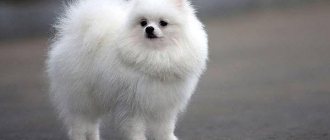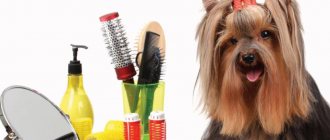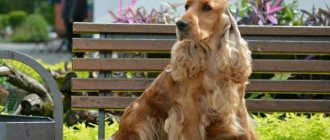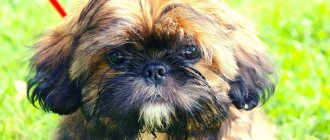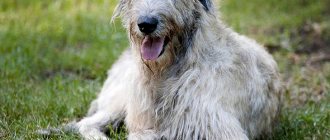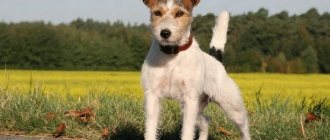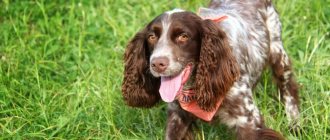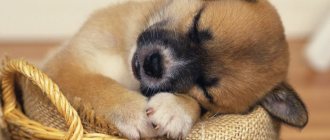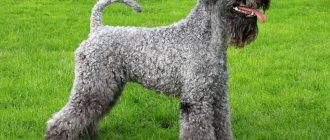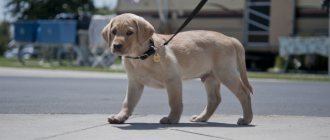Labrador dog hygiene includes caring for the coat, nails, teeth, skin and ears. There are certain rules for caring for a dog of this breed.
Labrador Retriever dogs have been one of the most popular pets for many years. If we consider large breed dogs, Labradors are not considered the most demanding pets in terms of caring for them. But this does not mean that the future owner of a dog of this breed can ignore the rules of Labrador hygiene. High-quality care for your pet’s fur, claws, mouth and ears will help maintain its external attractiveness, as well as avoid ear and skin diseases.
Wool
A shiny and thick coat is the main decoration of any dog, and the Labrador is no exception. You need to think about the hygiene of your pet’s fur before he arrives in the house. Even though a dog's coat is easy to brush and wash, there are certain hygiene rules that must be followed.
The Labrador's coat consists of a thick, soft undercoat and long, non-curly but thick hair. Several times a year, a dog of this breed sheds intensively, which creates a lot of trouble for the owners associated with cleanliness in the apartment. Brushing helps to quickly cope with the consequences of shedding. This procedure allows you to clean the coat of dead hair, as well as reduce the frequency of cleaning your home. Combing is also necessary in the spring and summer, when the dog needs to be regularly checked for ticks. They also comb the dog after walks in the forest, after which dry leaves and thorns remain on the animal’s fur.
Caring for your Labrador's coat begins with choosing the right brushing tool. As soon as a puppy appears in the house, you need to purchase several combs. One of them is the furminator - a device for combing dogs and grooming. The advantages of a Furminator for Labrador are as follows:
- The comb effectively removes dead hair without damaging the dog’s skin;
- promotes uniform distribution of natural skin lubrication;
- provides prevention of tangles;
- reduces the duration of seasonal molting.
For Labradors, you need to purchase a large furminator, which allows you to process large areas of fur at a time. The Furminator is used after preliminary bathing and drying the coat. If you don’t wet your dog before brushing, the teeth of the device will quickly become clogged with dirt and ruin the healthy coat.
The Furminator is a device that is recommended to be used no more than once a month if the dog does not shed. During the molting period, the number of procedures is increased to two per month.
To care for the coat, you also need to buy a comb with fine metal teeth. You will need it to comb out ticks, dirt and thorns, which not only spoil the coat, but also pose a threat to the health of your pet.
Bathing is another component of Labrador coat care. Bathing differs from washing in that shampoo is used for the first procedure. The choice of this hygiene product must be taken responsibly. Labrador is a breed that is prone to allergies and dermatitis. When purchasing shampoo for your pet, pay attention to the instructions for the selected shampoo. The care product must be hypoallergenic and free of dyes and fragrances. To wash your puppy's bath, purchase shampoo intended only for puppies.
You should bathe your Labrador with shampoo no more than once every 2-3 months or if necessary, for example, after your dog has swum in a dirty lake or has been hunting. Performing the procedure too often provokes shedding and degreasing of the Labrador's coat, which causes the pet's coat to become dull and thin.
If you have completely bathed your dog, take care to thoroughly but gently dry the hair. A bath towel will help remove residual moisture, but you should not use a hairdryer or other drying devices, since dry hot air quickly spoils the hair and provokes dehydration of the skin.
First bath
The first bath should be as comfortable as possible. The wrong approach can frighten the baby and make washing in the future not a pleasant experience, but a terrible execution.
Following simple rules will help you to endure this activity calmly, and perhaps even fall in love with it:
- the water temperature should be close to the dog’s body temperature – 36-40 degrees Celsius;
- the bottom of the bathroom should be covered with a rubber mat, diaper, towel so that the pet’s paws do not slip or move apart;
- water should not get on the face, eyes or ears;
- The wool should be well moistened before applying shampoo;
- do not apply shampoo directly to the coat - dilute it in a small amount of warm water, this will make it easier to foam and avoid intensive soaping, which can tangle the coat;
- Lather your back first, carefully moving up to your head, rinse off the shampoo the other way around - from your head down;
- repeat 2 times;
- After bathing, wrap the puppy in a towel, dry the coat well, let it dry almost completely, then dry it with a hairdryer and comb it.
You can read more about bathing in the articles: “How often can you wash a dog”, “Caring for a dog’s coat”. Possible problems with fur due to improper care are described in the article: “Dandruff in dogs and methods of treating it.”
Claws
Nail trimming is an unpleasant but necessary procedure for a Labrador dog. You need to accustom your pet to nail hygiene from the first months of life. A puppy's claws grow quite quickly, causing the dog's toes to become splayed, which interferes with the formation of healthy limbs.
To trim the puppy's cat, use manicure clippers designated for dog hygiene. The procedure must be performed very carefully, cutting off only the “hook” of each claw. If the owner accidentally cuts off the part adjacent to the puppy’s finger, this will lead to bleeding and severe pain, after which the animal will be afraid of the nail trimming procedure for quite a long time.
Adult Labradors, whose limbs are properly formed, sharpen their claws during walks. But do not forget that dogs have a fifth toe, the claw of which does not grind off on a hard surface. It is this claw that needs to be trimmed using a nail clipper purchased at a pet store.
Labrador Retriever Care
They begin to accustom a puppy to hygienic bathing at 2-2.5 months. This period marks the beginning of training, and he will easily learn new rules of behavior.
This is interesting: Labradors have a thick undercoat, which allows them to stay in cool water for a long time. Thanks to the undercoat and the active work of the sebaceous glands, the coat does not get wet and thermoregulation is not disturbed. Therefore, the breed is ideal for hunting waterfowl.
Veterinarians give several recommendations regarding the care of such dogs:
- Special detergents should be used no more than 3-4 times a year. This reduces the risk of drying out the guard hair and undercoat;
- Brush thoroughly after bathing. This allows you to maintain the dog’s impeccable appearance and facilitates daily care;
- Wash your paws after returning from outside without using detergent. Frequent use of shampoos or soap removes the secretion of the sebaceous glands from the surface of the hair. It becomes excessively dry and brittle. The exception is heavy pollution;
- Wearing special clothing (overalls, jackets, pants, etc.) reduces the amount of pollution during a walk.
By following the advice of veterinarians, the owner will be able to properly care for his four-legged friend.
Ears and skin
Labradors are dogs that have floppy ears. Due to their anatomical features, the ears are poorly ventilated, which increases the tendency to inflammation. Several times a week, the dog’s ears should be wiped with a cotton ball soaked in saline solution. You can also buy a special ear care product at your veterinary pharmacy.
The condition of the ears and skin should be regularly monitored. As soon as symptoms such as redness, flaking, an unpleasant odor and scabs appear, you should immediately take your pet to a veterinarian.
Frequency of procedures
When you can bathe a puppy for the first time is therefore clear. But how often should this procedure be performed in the future? Unfortunately, there is no clear answer to this question. The frequency of water procedures for a puppy depends on many factors.
If a dog, for example, was purchased to guard a private home and is kept outside in a kennel, then, of course, you may never have to bathe it at all. If the dog was bought to live in an apartment, he will most likely have to take water treatments quite often.
The frequency of bathing a puppy depends primarily on how quickly its fur becomes dirty. In autumn and spring, in damp weather, you will most likely have to wash your dog more often. In summer and winter, dogs' fur becomes dirty more slowly. Accordingly, the animal will have to take water treatments less often.
Usually, owners of puppies when keeping them in an apartment bathe them once every 1-1.5 months. In any case, it is not recommended to wash your pet too often before 6 months.
We suggest you read: Training a Labrador at home
Fight against worms
Most often, Labrador is found with roundworms or tapeworms.
They can be found in the intestines, where they take all the nutrients.
If a severe worm infestation is detected, especially in children, it can cause a noticeable deterioration in the dog’s condition. Most often, roundworms attack puppies.
Adults do not often pick them up. Sometimes puppies are born with roundworms, or rather, their larvae.
This is why serious breeders remove worms from puppies more than once at the age of two months.
When purchasing a Labrador, you should ask the breeder what product he used and at what period the course should be repeated.
If this infection is not cured, it threatens the health of the Labrador and the people around it. Young children should be especially protected from this fact.
You need to make sure that your dog is constantly protected from worms and does not lick children.
As mentioned, adult dogs are less likely to have roundworms, but they are often attacked by tapeworms.
The carriers of their eggs are fleas. If a flea bites a dog, the second one is already infected with tapeworms.
There are an impressive number of tapeworms. Humans are especially afraid of the “bovine” tapeworm, which is carried in the intestines of sheep, as well as large horned animals, fish and game.
To carry out anthelmintic treatment for a retriever, you can purchase different medications. As a rule, only roundworms are removed from puppies.
Combination drugs are excellent for treating adult pets, as they affect both tapeworms and roundworms. The drug is dosed strictly according to the weight of the animal.
A Labrador needs anthelmintic treatment once a quarter, especially if there are small children in the family.
Raw carrots, pumpkin seeds, garlic, etc. are perfect for this purpose, but this does not provide a 100% guarantee.
Keeping a dog
Keeping a Labrador in an urban environment is possible if you allocate enough time for walks. These are active dogs and require a lot of space. A large apartment will be preferable to a one-room apartment. A private house with its own yard is even better.
A Labrador does not need a closed house. A bed made from natural materials, chosen taking into account the size of the pet, is enough. It must be cleaned daily.
In addition to the bed, your pet will need bowls for food and water, a collar with a leash, and toys. As well as care products: comb, massage brush, nail clipper, etc.
Dogs of this breed tolerate winter well, so it is possible to keep them outside. For the construction of an enclosure, select a corner of the yard with a good view. The minimum area of the territory is 5-7 meters.
If it is not possible to arrange an enclosure in the shade of trees, then you can make a canopy. This will help protect your dog from direct sunlight.
To protect from cold, rain and wind, you need an insulated booth. Consider the size of your pet. It is necessary that it fits there with its paws extended. The height of the entrance to the kennel should be sufficient to prevent permanent arching of the Labrador's back.
How to wash a Labrador puppy
It’s hard to say whether the character of a girl or a boy Labrador is “softer”; you can’t guess here.
This animal does not require special care: brushing the fur is quite enough. Walk for at least an hour and let your Labrador run around as much as possible. A special feature of the breed is its focus on close contact with humans, so try to pay enough attention to your pet. Training won't hurt. Otherwise, he will bark monotonously. If we talk about Labrador puppies, the nature of the kids is more restless, but this will pass with time.
Monitor the animal's diet. Labradors are not picky eaters. What they don't eat, they chew. Young animals gain weight especially quickly. This is another reason why it is necessary to exercise your dog physically. If she does not “run out” excess energy, then it is quite possible that she will spoil some thing at home.
These dogs have many talents: they are irreplaceable during hunting, in rescue services, at customs, and as guides for the blind. This is a loyal companion who will very quickly become a member of your family.
Veterinary medicine and vaccination
The first vaccination is given to a Labrador at the age of 8-9 weeks. 10 days before this, the puppy needs to be rid of worms. Vaccination is carried out only for healthy dogs.
A month later the vaccination is repeated. Only 2 weeks after the second stage, the puppy can be taken out for its first walk and introduced to other dogs.
Vaccination is carried out strictly according to a schedule from which one cannot deviate.
At 6-7 months, after a complete change of teeth, the Labrador is given a third vaccination and an anti-rabies drug is administered.
The dog will be given a veterinary passport, which will indicate which vaccine and at what age it received.
After the procedure, the puppy is quarantined for 10-14 days. He should not have contact with other animals. Do not wash your pet or get the injection site wet.
Then the vaccination course is carried out once a year at the discretion of the owner. Only a rabies injection is required.
If the owner provides the Labrador with the right lifestyle, then his health can be called good. However, there are a number of diseases to which they are susceptible:
- obesity;
- dysplasia of the hip and elbow joints;
- Panostitis is an age-related disease caused by an inflammatory process in the internal canal of long bones. Puppies aged 6 to 18 months are affected;
- osteochondrosis;
- licking granuloma - an ulcer on the leg caused by idiopathic licking;
- retinal atrophy, cataract;
- ear infection;
- epilepsy.
